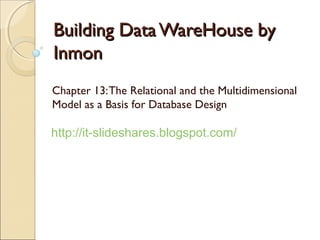
Building Data Warehouses with Relational and Multidimensional Models
- 1. Building Data WareHouse by Inmon Chapter 13: The Relational and the Multidimensional Model as a Basis for Database Design http://it-slideshares.blogspot.com/
- 2. Contents The Relational Model The Multidimensional Model Snowflake Structures Differences between the Models Independent Data Marts Building Independent Data Marts Summary
- 3. The Relational Model Organize data into a table Normalization of data implies that the database design has caused the data to be broken down into a very low level of granularity
- 4. The Multidimensional Model Sometimes called the star join approach Components: ◦ A fact table is a structure that contains many occurrences of data. ◦ Dimensions table, which describe one important aspect of the fact table
- 5. Snowflake Structures More than one fact table can be combined in a database design to create a composite structure called a snowflake structure Advantage of the multidimensional design is its efficiency of access
- 6. Differences between the Models The Roots of the Differences ◦ The relational model is shaped from a data model. ◦ A star join is shaped from user requirements.
- 7. Differences between the Models Reshaping Relational Data ◦ The base data in the relational model can be shaped and reshaped in as many ways as desired
- 8. Differences between the Models Indirect Access and Direct Access of Data ◦ The relational model is good for indirect access of data ◦ The multidimensional model is good for direct access of data
- 9. Differences between the Models Servicing Future Unknown Needs ◦ The granular data in the relational model is used to service unknown future needs for information
- 10. Differences between the Models Servicing the Need to Change Gracefully ◦ Another advantage of the relational model as a basis for the data warehouse—the ability to change gracefully ◦ The impact of change is minimal
- 11. Differences between the Models Servicing the Need to Change Gracefully ◦ The relational model forms an ideal basis for the data warehouse, while the star join forms the ideal basis for the data mart.
- 12. Independent Data Marts Data Marts ◦ A data mart is a data structure that is dedicated to serving the analytical needs of one group of people ◦ The independent data mart is a data mart that is built directly from the legacy applications
- 13. Independent Data Marts Data Marts ◦ A dependent data mart is one that is built from data coming from the data warehouse ◦ The dependent data mart requires multiple users to pool their information needs for the creation of the data warehouse
- 14. Building Independent Data Marts Problem with building independent data marts ◦ Do not provide a platform for reusability ◦ Do not provide a basis for reconciliation of data ◦ Do not provide a basis for a single set of legacy interface programs ◦ Do require that every independent data mart create its own pool of detailed data, which is, unfortunately, massively redundant with the pools of detailed data created by other independent data marts
- 15. Building Independent Data Marts With dependent data marts, all problems of independent data marts are solved
- 16. Summary Basic models that are used for database design for the data warehouse: the relational model and the multidimensional (star join) model The relational model is ideal for serving indirect access to the data warehouse, while the multidimensional model is ideal for serving the needs of the direct use of the data warehouse. Dependent data marts that take data from a data warehouse do not have to have the same set of architectural problems (like independent data marts). http://it-slideshares.blogspot.com/
Notes de l'éditeur
- There are two basic models for database design that are widely considered—the relational model and the multidimensional model. The relational model is widely considered to be the “Inmon” approach, while the multidimensional model is considered to be the “Kimball” approach to design for the data warehouse.
- In a snowflake structure, different fact tables are connected by means of sharing one or more common dimensions. Sometimes these shared dimensions are called conformed dimensions.
- The merging of relational tables to create a new relational table is easy for several reasons: ■■ Data is stored at the most granular, normalized level. ■■ Relationships between relational tables are already identified and have a key-foreign key manifestation. ■■ New tables can contain new summaries, new selection criteria for those summaries, and aggregations of the base data found in the relational table.
- No guarantee that the star join that is optimal for one group of users will contain the data needed for another group of users
- The relational model is designed to be used in an indirect fashion. This means that the direct users of the data warehouse data access data that comes from the relational model, not data in the relational model itself. When it comes time for change, the impact is minimal because the different users of the data warehouse are accessing different databases.
- The dependent data mart requires multiple users to pool their information needs for the creation of the data warehouse. In other words, the dependent data mart requires advance planning, a long-term perspective, global analysis, and cooperation and coordination of the definition of requirements among different departments of an organization.
- Independent data marts represent a short-term, limited scope solution where it is not necessary to look at the global, long-term picture. Dependent data marts, on the other hand, require a long-term and a global perspective. But independent data marts do not provide a firm foundation for corporate information, while dependent data marts indeed do provide a sound long-term foundation for information decisions.